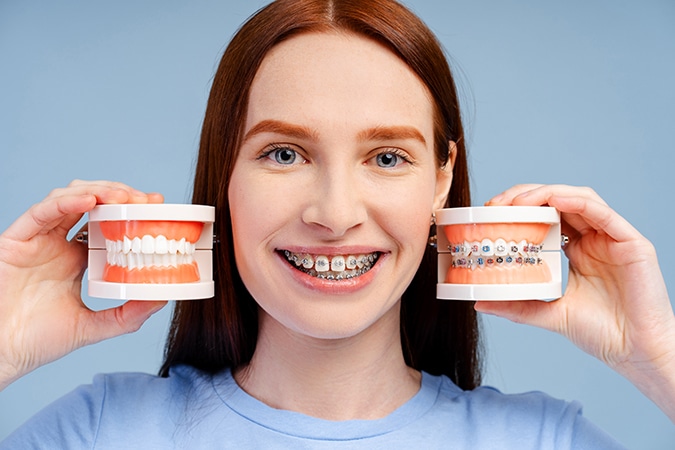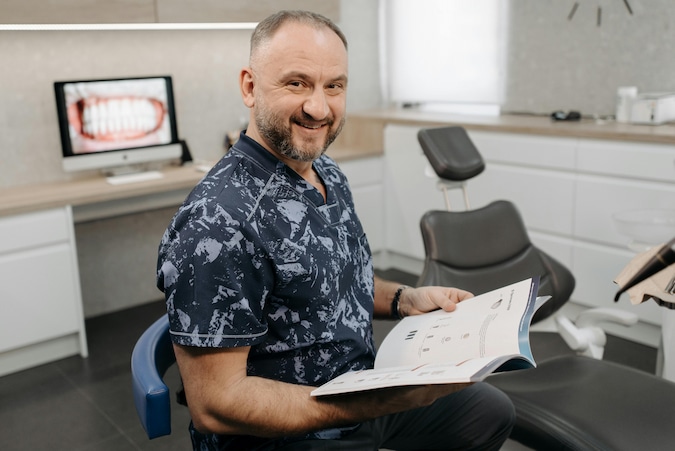
Does Dental Insurance Cover the Cost of Braces?

Navigating the labyrinth of dental insurance terminology and insurance coverage options for braces coverage can feel intimidating. But fear not, as many insurance plans often incorporate orthodontic benefits. Let’s illuminate the mystery of dental coverage for braces, offering crystal-clear guidance on eligibility and trade secrets to maximize your benefits.
At Selfgood , we don’t merely pledge an excellent dental plan. We make it a reality! It’s more than just about pocketing savings. It’s about nurturing a healthier you. Let’s untangle this puzzle together: Do insurance plans genuinely cover braces? With Dental Insurance Shield , Selfgood offers more than a dental plan. We enable our members to conserve funds while advocating for a wellness-focused lifestyle.
Key Takeaways
-
Dental insurance plans for braces vary widely in coverage, including variables like deductibles, network size, waiting periods, and lifetime maximums.
-
Dental insurance plans impact the extent of support for orthodontic costs.
-
Coverage for braces under children’s and adults’ dental insurance plans is often restricted.
-
Age, medical necessity, and type of braces can be factors, with adults facing more challenges in obtaining coverage.
-
Options aside from private dental insurance, such as government programs like Medicaid and Medicare, offer strict and limited coverage for braces.
-
Flexible Spending Accounts (FSAs) and Health Savings Accounts (HSAs) can provide flexible spending alternatives using pre-tax dollars.
Understanding Dental Insurance for Braces

Deciphering the complexities of dental insurance plans regarding braces can be a formidable task. The intricacies involve various factors, including the type of plan, deductibles, and limits on orthodontic coverage, that play crucial roles in determining what expenses are covered. A thorough understanding of these elements is essential for demystifying how dental insurance covers braces.
The extent to which dental insurance plans cover procedures like braces varies considerably. Some indemnity dental plans recognized by the American Dental Association offer coverage for such treatments based on specific procedures while allowing patients to select their preferred dentists.
In choosing an appropriate dental insurance plan with orthodontic coverage, investigate whether the plan covers braces. Then, assess other financial considerations such as monthly premiums, deductible amounts, and any established lifetime limits on orthodontic coverage.
Get the facts on dental care for adults without insurance cost – know before you go.
Types of Dental Insurance Plans
The diversity of dental insurance plans reflects the maxim that variety enhances our experiences, especially when selecting a plan for orthodontic treatments. Various types of dental insurance plans provide distinct health plan coverage options for such procedures. These include DHMO, PPO, and Dental Indemnity plans.
Dental insurance plans can vary significantly based on several factors:
- Network size
- Deductible amounts
- Waiting periods before treatment begins
- Annual maximum payouts
- Co-payments
- Percentages covered by co-insurance after deductibles
- Monthly or yearly premiums, and
- How much value you get
All factors influence what kind of work gets done on one’s teeth and its accompanying expense.
Selecting an appropriate dental insurance plan is more complex than opting for one with minimal premiums. Identify a plan that delivers optimal benefits tailored towards meeting individual requirements regarding corrective measures taken within mouth and jaw areas. Included under the “orthodontics” category among indemnity healthcare services dentistry professionals offer today. Here are key considerations:
-
The breadth and quality inherent within provider networks
-
Initial out-of-pocket expenses, aka “deductibles”
-
The potential delay between the initiation date versus the actual onset date because of specific provisions termed “waiting periods” encoded into policies themselves before receiving full reimbursement entitlements afterward
-
Caps are applied annually concerning total reimbursable expenditures permitted, commonly called “maximum annual coverages.”
Coverage Factors
Navigating the complexities of dental insurance plans for braces requires attention to crucial coverage factors. These critical elements comprise:
-
Age restrictions
-
Proportions of orthodontic services covered
-
Periods before coverage begins, known as waiting periods
-
Maximum lifetime allowance for orthodontic treatments
For example, while Medicaid may offer braces coverage if deemed a medical necessity, you must be mindful of significant limitations that come along with it. Insurance plans vary widely regarding age limits. Some provide insurance explicitly catering to children’s orthodontics, while others extend their benefits to cover adults’ needs based on the specific terms set by the plan.
Delving deeper into your dental insurance plan will reveal several important aspects.
-
A typical characteristic is that these plans usually pay a defined percentage—often about 50%—of orthodontic treatment costs until reaching an established limit as a “lifetime maximum.”
-
Notably, this coverage percentage might only kick in once yearly ceilings and other constraints have been met.
-
Many dental insurance providers include waiting periods within their policies.
-
The waiting period could affect when you can access your required treatment. This factor requires careful consideration during the planning stages.
How Dental Insurance Covers Braces for Children and Adults

Regarding the intersection of dental insurance and braces, a prevalent inquiry is about how much one’s dental insurance plan will foot the bill for orthodontic services. Regrettably, providing an outright answer can be complex. Dental insurance plans come with caveats and exceptions that may not extend full coverage for the expenses incurred from braces. Such limitations in your policy could manifest as:
-
Specified waiting periods before you can access benefits
-
Age-specific eligibility criteria for receiving coverage
-
Caps on lifetime orthodontic coverage delineating a fixed sum paid towards brace costs.
In cases considered less severe—like minor teeth misalignments—you may not be eligible for braces coverage under many plans. However, you may access these services, subject to discretion, if they are a medical necessity. While private dental insurance policies might support orthodontic procedures like fitting braces, expect additional out-of-pocket expenditures through co-pays or other shared-cost mechanisms.
The level at which insurance supports such endeavors typically skews more favorably toward children than adults. Thus, adults seeking adult-specific orthodontic treatment face fewer options within various dental insurances even though providers like Delta Dental present solutions that include adult-oriented offerings.
Children’s Coverage
Dive into the thrilling world of dental insurance and confidently rule the waves of children’s orthodontic needs! It’s a wild ride with varying coverage for braces across family dental plans, typically offering benefits for those under 18.
- Consider, for instance, the power-packed Anthem’s Essential Choice PPO plan.
- It’s a game-changer, providing 50% coverage for child orthodontics with zero waiting time!
- Plus, it promises a lifetime maximum of $1,000. Sounds irresistible, right?
But hold your horses! It’s not just about the coverage. The scope of the provider network and the insurance provider’s reputation are other key players on the field that demand your attention. So, step up, take charge, and make an informed choice that will keep your family smiling!
Adult Insurance Coverage Options
Adult orthodontic care is not just a concern for children. Adults, too, require braces. The challenge they often encounter is securing dental insurance coverage that extends to orthodontic services.
- Many standalone dental plans do not offer the same benefits for adults as children.
- Typically, insurance policies favor traditional metal braces over options such as clear or ceramic ones.
- Clear or ceramic options may be seen as aesthetic choices.
There is some potential relief. If your dental insurance plan includes coverage for orthodontics deemed medically necessary, you may be eligible for more extensive orthodontic insurance coverage. When reviewing an insurance plan’s details, consider beyond merely premiums and networks. Verify whether it includes provisions specific to medically required orthodontics. It could diminish out-of-pocket expenses you might otherwise incur.
Navigating Government Programs and Alternative Payment Options
Insurance plans provided by private entities often include orthodontic coverage, such as for braces. However, they aren’t the sole resource available. Government-run programs like Medicaid and Medicare also extend a degree of orthodontic coverage. Their strict criteria for eligibility and limits on what’s covered might not align with everyone’s requirements. As an alternative strategy to handle orthodontic costs, individuals can use Flexible Spending Accounts (FSAs) or Health Savings Accounts (HSAs), which allow expenses associated with braces to be paid.
Government aid through these programs does bring some financial relief, yet it arrives attached to extensive regulations and conditions that must be navigated. In contrast, FSAs and HSAs are designed to offer a flexible method enabling individuals to pay off qualifying orthodontic charges using money that hasn’t been taxed. These accounts have constraints, including annual contribution maximums and rollover guidelines, that should be understood before committing funds.
Medicaid and Braces
Medicaid is a public assistance program that provides health care to various groups. You might be eligible if you have a low income or if you have children. It can also cover expectant mothers, older adults, and those with disabilities.
- Medicaid enforces rigorous criteria for orthodontic services, such as braces coverage. Typically, these are available to recipients earning below the poverty threshold defined by their state of residence.
- A narrow scope of orthodontic coverage exists for minors covered under Medicaid’s plans, accompanied by stringent conditions.
In some states, adults who qualify for Medicaid may receive dental coverage that includes medically necessary braces. The specifics surrounding eligibility and what makes up medical necessity can drastically differ from state to state, including factors such as age restrictions and other mandatory qualifications.
Navigating these limitations might suggest that Medicaid isn’t always ideal if you’re seeking support for the cost braces. However, his program could offer essential aid in managing financial expenses associated with your dental health needs.
Medicare and Braces
Medicare , the public health insurance program designed for those over 65, generally doesn’t cover orthodontic procedures like braces. But there are exceptions. Medicare might step in if braces are medically necessary due to an injury, disease, or accident. Even then, it’s usually limited to situations requiring hospitalization, like surgical or emergency orthodontic treatments covered by Medicare Part A.
Given these restrictions, consider exploring separate dental insurance plans for comprehensive brace coverage. Yes, it might seem daunting at first, but finding the right plan can save you from unnecessary financial stress and worry.
FSAs and HSAs
Flexible Spending Accounts (FSAs) and Health Savings Accounts (HSAs) provide a practical solution for managing orthodontic costs that government programs or comprehensive dental insurance may not fully cover. These financial vehicles can help pay for qualified healthcare expenditures, including procedures such as braces under orthodontic treatments.
Awareness of the distinct guidelines and restrictions associated with FSAs, and HSAs is crucial. For example, in 2022, individuals can contribute up to $3,650 and families up to $7,300 to an HSA account, while FSA contributions are capped at $2,850. It’s also essential to note that funds in an HSA carry over annually without penalty.
Money allocated in an FSA must typically be spent within the plan year, with some offering a carryover option limited to $550. Participation in an FSA is usually restricted around periods like open enrollment windows or following specific life events qualifying you for mid-year changes. Understanding these details ensures you can effectively leverage the advantages of FSAs and HSAs for their orthodontic needs.
The Cost of Braces: With and Without Insurance

A common concern when contemplating orthodontic treatment is the expense involved. The cost of braces can be pretty substantial without dental insurance. Patients might expect to pay anywhere from $5,000 to $6,000 for metal braces. Options such as lingual braces present an even higher price point, potentially costing up to $12,000. Achieving a perfectly aligned set of teeth represents a significant financial investment.
Dental insurance can provide some relief by covering around half the cost of getting braces until you hit your policy’s lifetime maximum benefit for orthodontic treatments, which typically varies between $1,000 and $3,000. Opting for ceramic over traditional metal varieties could influence your total covered expenses because of their higher costs.
Beyond purchasing the initial hardware itself, additional charges may arise throughout treatment. You may need regular adjustments, unforeseen emergency appointments, and supplementary procedures. Ultimately, those extras may lead to out-of-pocket despite having insurance coverage.
Finding the Right Insurance Coverage Options for Braces
Choosing the right dental insurance plan for braces shouldn’t be a toothache. Think of it like hunting for the perfect pair of shoes – it has to match your needs, comfort, and budget.
Sounds complex? Don’t worry.
Securing the right coverage doesn’t have to be an uphill battle. The right steps can be as smooth as a freshly flossed smile.
To find a plan that eases the cost of braces, you’ll need to commit to an insurance company and set up monthly premiums. But before you take the plunge, here’s what you need to consider:
- Grasp the nitty-gritty of policy coverage
- Eye any age or treatment-specific limitations
- Compare the perks of potential plans
With these steps, you’ll be well on your way to finding the perfect plan to put a confident smile on your face—without the stress.
Assessing Current Insurance Coverage Options
Discover the power of choice in dental plans. Your first step is to understand your existing coverage thoroughly. Whether that’s a deep dive into your policy documents, a chat with your insurance rep, or a consultation with your employer or an agent, it’s all about knowing what you’ve got.
Your current plan might be private for you or your family or provided by your employer. It could even cover orthodontic care, like braces. But it’s all in the details.
- Take a closer look at your dental insurance.
- Find out if there are any exclusions, like certain types of braces.
- Check if extras like X-rays are part of the deal.
- Ask if there’s a limit on how many times you can get braces over a set period.
Knowing what your current dental plan covers is key. It empowers you to search for a new plan that better suits your needs. Make an informed decision and smile with confidence. Your perfect dental plan is just around the corner.
Comparing Plans and Providers
To effectively evaluate your potential dental insurance options, it’s essential to scrutinize various elements, including:
-
The cost of premiums
-
Limits on coverage
-
Required deductibles
-
Inclusion of adult braces in the coverage
Consider examining the breadth of their service network, customer satisfaction levels, and any extra perks that might come with a plan, such as discounts or additional dental services like tele-dentistry offerings.
Take, for instance, Spirit’s Core PPO dental insurance scheme, which provides:
-
Affordable average premium rates
-
Zero waiting period for benefits to kick in
-
A modest deductible of $100
-
An orthodontic lifetime maximum benefit capped at $1,200
-
Coverage is extended to children under 19 years old within its expansive network
The disparity between using an orthodontist who is part of your insurer’s network versus one who isn’t can be substantial. Speaking of which, you’ll encounter fewer out-of-pocket expenses when staying within the network. For example, Delta Dental’s PPO offering reveals an extensive preferred provider organization comprising over 112,000 dentists across the country—this could prove exceedingly helpful when looking for both convenience and compatibility with an orthodontist.
Orthodontic Treatment Alternatives and Insurance Coverage Options

Dental insurance may include coverage for orthodontic treatments beyond traditional braces. The growing popularity of less visible options like Invisalign and ceramic braces offers a more discreet method of teeth straightening, which might be included in the coverage based on your policy’s details.
Not every aspect of orthodontic care—procedures, exams, appliances—is guaranteed to be covered by insurance plans. Often, specified limits or percentages apply to such benefits. Coverage for alternative treatments like plastic aligners could still apply under an insurance plan that doesn’t expressly list ceramic braces. Examining and discussing all available treatment alternatives with your dental insurance provider is crucial before deciding what to do about braces coverage.
Invisalign
Looking for a sleek, discreet solution to perfect your smile? Consider Invisalign treatment.
- It’s a modern twist on traditional braces – no more metal brackets and wires.
- Instead, your teeth are gently guided into alignment with clear, custom-fitted plastic trays. Not only are they virtually invisible.
- They’re also tailored to your unique smile.
- It’s ideal for adults and teenagers seeking a less noticeable orthodontic solution.
But what about the cost? You might be in luck if you have dental insurance that includes orthodontic benefits. Take Delta Dental’s Premium PPO plan as an example. It offers a generous 50% allowance for orthodontic treatments, with up to $1,500 available for lifetime braces assistance.
Could this support extend to Invisalign? Absolutely! But it’s crucial to confirm with your insurance provider first. Make sure to check if Invisalign treatments fall within the scope of your current dental policy. A perfect smile could be more affordable than you think.
Ceramic Braces
Dive into the world of ceramic braces! They’re the stylish alternative to those antiquated metal relics that once dominated orthodontics. Masterfully camouflaging with your natural tooth color, they’re the fashion-forward solution to a perfect smile.
Sure, they could run you between $4,000 to $8,000 without insurance, but who said style comes cheap?
- The good news is your dental insurance might cover a chunk of that bill.
- Every plan is as unique as a snowflake. So, dig into the specifics to uncover how much your insurance is willing to pitch in.
- Got dental insurance benefits? Use them for orthodontic treatment! But remember, if the cost of your ceramic braces exceeds your policy limits, you’ll be footing the rest of the bill.
Despite the steeper price tag than their metal counterparts, ceramic braces are the go-to choice for those seeking a less conspicuous yet highly effective pathway to dental perfection.
Saving Money on Braces and Dental Insurance
Your budget could be negatively affected due to the hefty price tag attached to braces and dental insurance. You have many options to help cut down braces and dental coverage expenses. These options encompass:
-
Taking advantage of dental discount programs
-
Enrolling in membership plans
-
Obtaining discounts for paying the total amount upfront
-
Exploring payment schemes offered by orthodontists
- Considering personal loans as a financing option
For instance, with an annual cost ranging from $150 to $200, dental discount programs provide reduced rates on braces and do not have limitations or waiting periods typically associated with traditional insurance plans.
Orthodontic insurance may shoulder up to $1,500 worth of brace costs, making its average yearly premium expense—estimated at around $648—a worthwhile investment. Even though choosing a dental savings plan might lead to heightened demand for appointment slots compared to standard insurance network services, it’s still an effective way to mitigate orthodontic expenditures.
What’s Next: Insurance Coverage Options
Ready to unravel the complexities of dental insurance for braces? Fret not. This guide is your roadmap. It breaks down everything you need—from understanding your insurance options and comparing providers to exploring treatments like Invisalign and ceramic braces. It even sheds light on government programs and alternative payment options. Here’s the truth: investing in your smile is an investment in your health and confidence, and yes, it can be wallet-friendly, too, with the right insurance.
With more than 400,000 access points across our national and regional networks, Dental Insurance Shield offers unmatched choice and value. Want to maximize your savings? Visit a dentist within our vast network. But if you want a change, pick any licensed dentist nationwide. Your ideal dentist is just a click away at MyRenProviders.com.
Bid farewell to costly dental care. Embrace healthy, radiant smiles without breaking the bank!
Frequently Asked Questions
Why are braces so expensive?
Braces are expensive because the materials and fabrication process, especially for clear braces, are labor-intensive and involve harder-to-get materials. This results in higher overall costs.
How long do braces take?
The treatment time for braces typically spans between 12 and 24 months, contingent upon the severity of the orthodontic condition being addressed. Less complex cases may require a shorter period to correct.
How much is braces for teeth?
According to internet data, braces without insurance typically range from roughly $3,000 to $8,500.
Does dental insurance cover braces for adults?
Dental insurance plans for adults are expected not to include coverage for braces, and locating separate plans that offer such coverage can be challenging. While specific insurance plans may provide benefits specifically for metal braces, they often exclude clear or ceramic options.
Should the need for orthodontic care arise from medical necessity, there may be an opportunity to obtain more extensive insurance coverage.
What are some alternative orthodontic treatments to traditional braces?
Some alternative orthodontic treatments to traditional braces are Invisalign and ceramic braces. Dental insurance may cover these options more.




